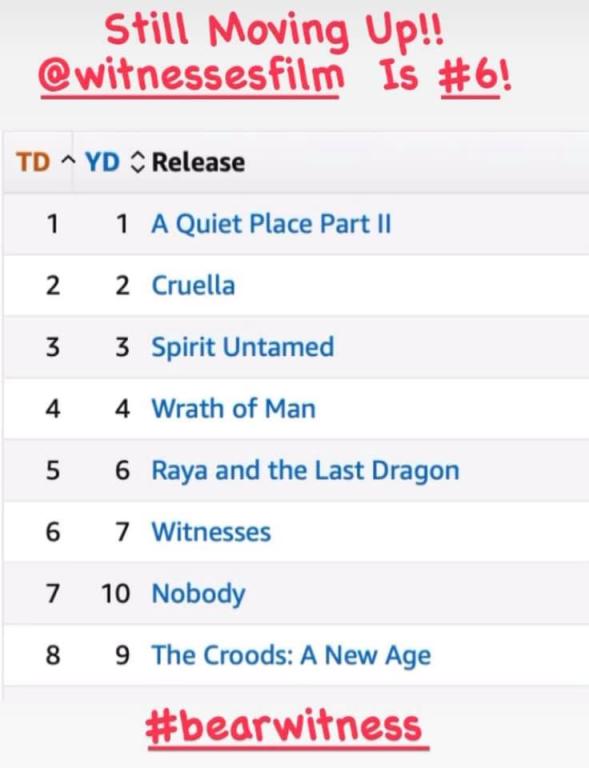
***
As you can see from the illustration above, the Interpreter Foundation’s film Witnesses ranked at Number Six on Box Office Mojo for Tuesday, 8 June 2021. Of course, in the interest of full disclosure it has to be frankly admitted that the box office receipts for Witnesses come in at slightly less than a third of those for Raya and the Last Dragon, which is ranked just above it at Number Five. But they’re very nearly nine times those of Number Seven, Nobody. Our little indie film is playing respectably in the big leagues: The movies that are immediately ahead of us in the rankings come, respectively, from (1) Paramount Pictures, (2) Walt Disney Studios, (3) Universal Pictures, (4) United Artists, and (5) Walt Disney Studios. Those ranked immediately after us are both from Universal Pictures. Not bad company to keep!
I want to thank all of those who have gone to see the film, invited neighbors and family and friends to watch the film, and organized private screenings of the film. If you haven’t yet seen it, please do. If there are others who, you think, might enjoy or benefit from it, please encourage them to take in a theatrical screening. If you don’t know where it’s playing, or if you would like it to come to a theater near you, please go to witnessesfilm.com and follow the instructions there.
I must candidly acknowledge, however, that my appreciation for you doesn’t seem to be universally shared. One critic of the film, who is (a) apparently a former Latter-day Saint and who has (b) not seen it, was so incensed by one of the positive reviews given to Witnesses on Rotten Tomatoes that, after quoting from the review, he declared its author a “hayseed” and a “dimwit.” (He writes on a message board that is giddy with delight at the fact, as they see it, that Witnesses is already a spectacular and embarrassing flop.) Of course, this seems to be the same high-value commentator who describes the faith of the Latter-day Saints as a “gauche, low-intelligence religion” that “worships the dollar,” embodied in a church that is directed by leaders whose teachings are “as dull and stupid as possible,” “as dull and dim as their members are.” Members of the Church, he says, “revel in their emotional and intellectual mediocrity.” “What a foolish people they are!”
Given those sentiments, I’m not sure that he represents the primary audience that we had in mind for Witnesses.
Incidentally, if the same things were said about, say, Black Evangelicals, or Jews, or Muslims, or Catholics, or the Native American Church, or Sikhs, would anybody out there have any difficulty at all in recognizing them as the ravings of a shameless bigot? So far as I’m aware, though, none of his confreres have expressed any even slight discomfort or reservations about his opinions.
***
More than a few of those who actually have seen Witnesses have expressed interest in obtaining the movie’s soundtrack. That has never been an item on our agenda, to be honest, but the level of interest has caught our attention. We’re looking into the possibility. If it doesn’t cost too much money or labor and if we can do it without major financial loss — we don’t anticipate any significant “profit” from the effort — we may be able to do it.
***
This little item, which was written by the husband of my patient and long-suffering wife, appeared yesterday in Meridian Magazine. You might find it of at least minimal value:
“Why Do We Care If There Were Witnesses?”
Mark your calendar for this coming Sunday evening, 13 June 2021, at 6 PM, Utah time:
“Free, Virtual Fireside with Susan Easton Black on theBook of Mormon Witnesses”
You might also enjoy these two short pieces:
“Why Is David Whitmer’s Witness of the Book of Mormon So Compelling?”
“Why Was David Whitmer Excommunicated from the Church?”
***
And, now, here’s a portion of a column that I published in the Deseret News back on 27 March 2015:
Some critics of Joseph Smith mock the fact that part of the Book of Mormon translation process apparently involved dictating while looking at a stone that he’d placed within a hat.
Yet far from being damaging evidence against his claims and against the Book of Mormon, this fact may strongly support their plausibility. The Lord has said that he makes (seemingly) weak things become strong (Ether 12:27), and this seems yet another such case.
Consider a smartphone or e-reader, for instance. Their screens are very difficult to read out in the sunlight and need to be shaded. Or consider your personal computer. You probably don’t place it directly in front of a window where bright light will be streaming into your face. You need contrasting darkness so that you can see the screen without strain, and especially so if you’ll be working on it for lengthy periods. Otherwise, your eyes will tire and your head will ache.
Now consider Joseph Smith. According to those familiar with the process, he dictated the Book of Mormon from words that somehow appeared in a “seer stone” or (much the same thing) in the Urim and Thummim. He rarely if ever actually had the plates with him; he couldn’t read what was on them except through revelation anyway, and he could receive revelation (via the “interpreters”) just as easily without the plates as with them. (So why were the plates necessary? Perhaps, among other things, to reassure him and the witnesses who saw and testified of them — and, thus also, us — that he was dealing with something objectively real and external to himself.)
Evidence indicates that Joseph dictated the Book of Mormon over the course of three months (or perhaps somewhat less). His scribes needed light in order to work, but it’s quite understandable that Joseph sought to reduce the fatigue of his eyes by using a hat to exclude the ambient light.
The implications of this, however, are intriguing. A manuscript hidden in the bottom of a hat would be difficult if not impossible to read. Yet Joseph dictated the Book of Mormon — roughly 270,000 words — in somewhere between 60 and 90 days. That’s approximately 3,000 to 4,500 words each and every day, without rewrites or significant revisions. (Practiced writers will instantly recognize this as a stunning pace.) Or, to put it another way, this young man, with only about two months of schooling, dictated roughly six to nine pages of today’s printed English edition every single day for two or three months.
Had he memorized it? That seems unlikely.
Was he creating it on the spot? That would have been an astonishing achievement. And the evidence seems against it.
For example, he himself was sometimes surprised by what he read. He couldn’t pronounce many of the proper names, for example, and had to spell them out. He worried when he read about the walls of Jerusalem; he’d never seen a town surrounded by walls, and he needed his wife’s reassurance that this was true (see “David Whitmer Interviews: A Restoration Witness,” Lyndon W. Cook, Grandin Book Company, 1991).
When he came to a break in the text, he had his scribe write “chapter.” This happened throughout the book of 1 Nephi, for example, and it also occurred at the end of that book. But then, when they realized that they’d now reached a break between two independent books, they crossed out the word “chapter” and replaced it with “The Book of Nephi,” marking the opening of 2 Nephi (see “The Original Manuscript of the Book of Mormon: Typographical Facsimile of the Extant Text,” edited by Royal Skousen, FARMS, 2001; and Skousen’s “Translating the Book of Mormon: Evidence from the Original Manuscript,” in “Book of Mormon Authorship Revisited: The Evidence for Ancient Origins,” edited by Noel B. Reynolds, FARMS, 1997).
It appears, thus, that Joseph was dictating from an unfamiliar text. It also seems likely that what he was reading provided its own independent light source, such that he could read it even with ordinary light excluded, in what one historian famously called “a world lit only by fire.” That sounds very much like the translation method described by the Prophet and other witnesses to the translation, but it’s difficult to reconcile with the theories that critics typically offer.
For more detailed treatment of the relevant issues, see “What the Manuscripts and the Eyewitnesses Tell Us about the Translation of the Book of Mormon” (published in 2002).
Posted from Newport Beach, California











